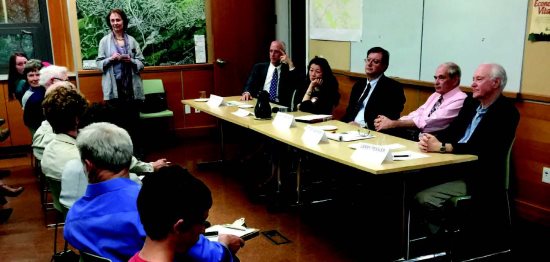
| ||||||
That was the consensus of five local business, government, and academic experts who offered their perspectives on the future of Lamorinda's retail business community at The Lamorinda Business Forum program, "The Future of Retail: What Will Downtown Look Like 10 Years from Now?" It was jointly organized by the Orinda, Lafayette, and Moraga Chambers of Commerce.
The panelists in the informal evening discussion in a program at the Orinda City Offices on April 25 were Lafayette City Manager Steve Falk; Irene Chen, owner of fashion accessory business Parker Thatch, which conducts much of its sales activity online; Saint Mary's College business professor Tomas Gomez-Arias; Orinda Interim City Manager Steve Salomon; and longtime retail business consultant Larry Tessler. All agreed that the retail business is undergoing rapid and dramatic changes nationally, and that these changes are reflected in various ways in Lafayette, Moraga and Orinda.
Nationally, retail businesses are failing at an increasingly rapid pace, victims of e-commerce and a glut of stores, particularly department stores, electronics and apparel shops, according to a recent Bloomberg News report. In Lafayette, Falk has observed dramatic changes in the urban fabric along Mt. Diablo Boulevard during his tenure of more than 20 years as city manager: There are no longer shoe stores or a camera shop, and the last electronics store, Radio Shack, closed recently. He attributes these changes to internet buying, and to traffic and congestion, the latter ironically due in part to the local success of other retail food stores and restaurants.
Retail stores that sell an experience involving more than merely buying merchandise are increasingly attracting customers, such as restaurants and spas.
"You can't get that online," says Chen. "The challenge is becoming nimble" to create a desirable experience that will bring customers in and keep them there, she says. She uses new tools like Facebook Live to achieve this with her brick-and-mortar stores.
Transportation is also a key factor, says Salomon, and it is changing fast with the advent of companies like Lyft and Uber. Throughout most of his career in city government everything has revolved around parking, but this will be altered dramatically, he predicts. Not only is sharing rides a new trend that changes the equation, but the advent of new kinds of two- and three-wheel vehicles is playing a part, too.
Salomon sees the internet as a phenomenon that is driving the reduction of square footage by successful new retailers like Amazon, which uses different merchandise stocking practices than traditional large retail stores. Malls are just not going to make it in the world of mixed-use development, predicts Salomon. In an era when retail is an experience, malls will have to be entertainment centers, Tessler agreed.
So what will Lamorinda look like in 10 years? People want the experience of a hometown, says Falk. In Lafayette this has translated successfully into growth of the city's downtown restaurant row, and he expects to see more. As to the proliferation of like businesses in a retail neighborhood, there is a "secret of clustering," he says, which accounts, for example, for the substantial increase of Diablo Foods' business after Trader Joe's opened its store in Lafayette. Contrary to the intuitive assumption that such competition is destructive, customers seem to be drawn to clusters of similar businesses for their shopping experience.
Reach the reporter at:
